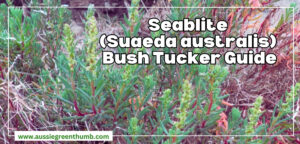Boasting bold goblet-shaped flowers with fluffy centres and vibrant displays of colour, the Protea is a must-have addition for those who love wildflowers and any gardener looking for an eye-catching addition to their landscapes.
These hardy evergreens share many of the same growing requirements as some of our most beloved natives and they can seamlessly integrate themselves into any garden setting. Here is your full guide to growing and caring for the Protea.
More...
Genus: | Protea |
|---|---|
Species: | Many available |
Family: | Proteaceae |
Common Names: | Sugarbush |
Location: | Outdoor |
Type: | Flowering plant |
Growth: | Varies depending on the variety |
Sun requirements: | Full sun |
Foliage Colour: | Green |
Flower Colour: | Pink, red, white (depending on variety) |
Flowering: | Late winter to spring |
Maintenance level: | Medium |
Poisonous for pets: | Flowers, nectar and seeds are highly toxic to humans and pets |
Getting to Know the Protea
The protea plants come in many stunning varieties and cultivars, each with its own growing characteristics and flower colours. Whether you are looking at establishing one in your garden or a pot, there’s bound to be the right pick for your needs.
Proteas do require a little know-how and effort to establish, meaning they may not be the right choice for a new gardener. However, once they are established, these showy wildflowers are pretty easy-going and very hardy.
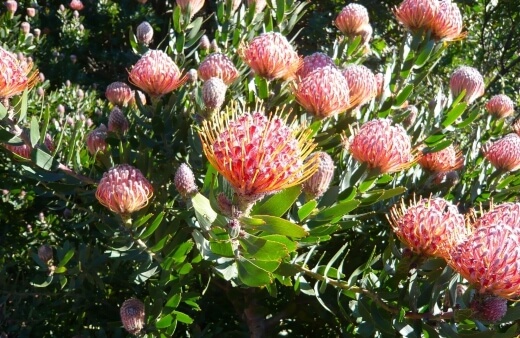
Contrary to popular belief, protea plants are native to South Africa where about 90 percent of the country’s proteas are found in what is known as the Cape Floristic Region which is a narrow stretch of the south and southwestern coastal mountain ranges, considered one of the world’s most biodiverse areas.
Protea, part of the Proteaceae family, is closely related to some of our showiest native plants like banksias, grevilleas and waratahs, so they are known to grow well in most Australian regions.
There are many different species of protea and many unique cultivars in the genus, some more popular than others. There are a few great options for those who are looking for a bigger garden plant and there are others that suit smaller potted positions outside.
The flowers make for excellent, long-lasting cut flowers for arrangements and these plants are commonly used as ornamental features in gardens, offering unique textures and colours to complement existing collections. Proteas can survive fires.
Most Popular Protea Varieties & Cultivars
King Protea (Protea cynaroides)Also known as the king protea, giant protea or king sugar bush, this is one of the most recognisable and popular proteas in the genus, sporting the largest flower heads that burst with pink and white hues. The king protea is the national flower of South Africa and grows to around 1 to 2 metres tall. | 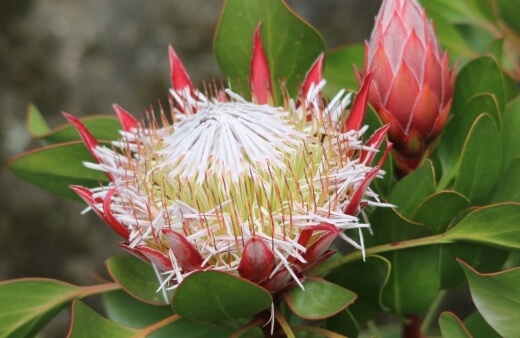 |
Narrow Leaf Sugarbush (Protea neriifolia)Commonly known as narrow-leaf sugarbush, this variety features cone-shaped pink flower heads with black feathery tips and an erect, shrub-like growth habit. Reaching about 3 to 5 metres in height, this species is a perfect ornamental addition to the garden. |  |
Common Sugarbush (Protea repens)Known as the common sugarbush, this variety grows more as an erect and dense shrub reaching about 1 to 4 metres tall. It produces showy deep-red or creamy-white flowers at the ends of the branches and is a very adaptable plant overall. | 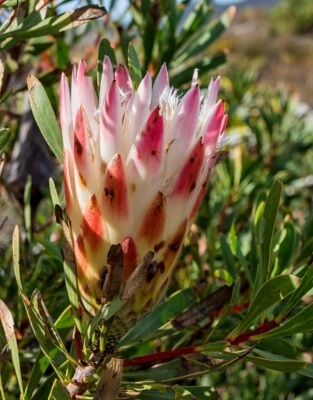 |
Wagon Tree (Protea nitida)Commonly known as wagon tree, this variety is one of the only proteas that grows as a large, slow-growing tree and it can reach up to 10 metres tall in good conditions. It has usable timber and produces fluffy white flowers atop leathery oblong leaves. | 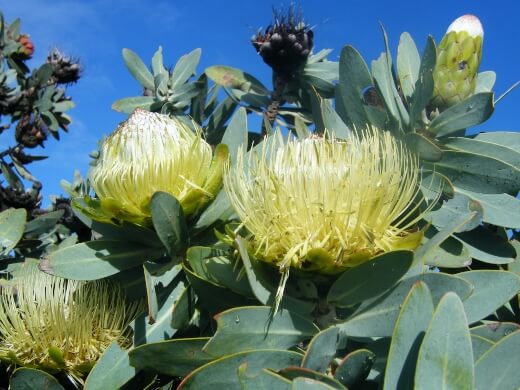 Source: en.wikipedia.org |
Bot River Protea (Protea compacta)This species is one of the best known in the cut flower industry, blooming with striking pink or creamy-white flowers shaped like a bowl atop slender, compact branches. It grows to form an erect and slender bush that can sprawl in richer soils. Grows to a maximum height of around 3 to 4 metres. |  |
Protea ‘Pink Ice’This is a hybrid cultivar that has become immensely popular in the cut flower industry. It boasts perky pink flowers and an attractive form. This variety also grows as a shrub that can reach up to 3 metres in height, meaning this plant makes for an excellent screening or hedging plant. |  |
Little Prince Protea (Protea cynaroides ‘Little Prince’)Perfect for those who don’t have enough space for the King Protea, this little brother version is more compact, reaching only about 1 metre in height in cultivation. Grows very well in containers. | 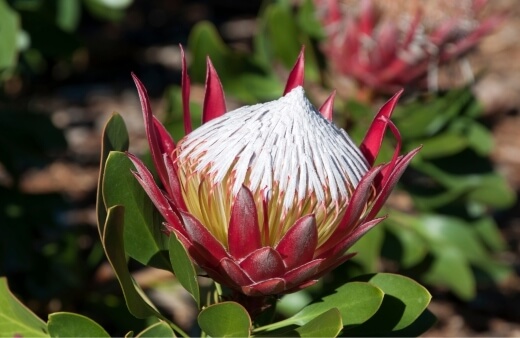 |
King Protea (Protea cynaroides)

Also known as the king protea, giant protea or king sugar bush, is one of the most recognisable and popular proteas in the genus, sporting the largest flower heads that burst with pink and white hues.
The king protea is the national flower of South Africa and grows to around 1 to 2 metres tall.
Narrow Leaf Sugarbush (Protea neriifolia)

Commonly known as narrow-leaf sugarbush, this variety features cone-shaped pink flower heads with black feathery tips and an erect, shrub-like growth habit.
Reaching about 3 to 5 metres in height, this species is a perfect ornamental addition to the garden.
Common Sugarbush (Protea repens)

Known as the common sugarbush, this variety grows more as an erect and dense shrub reaching about 1 to 4 metres tall. It produces showy deep-red or creamy-white flowers at the ends of the branches and is a very adaptable plant overall.
Wagon Tree (Protea nitida)

Source: en.wikipedia.org


Get Your Free Guide:
Master Growing Australian Natives eBook
A Must Have Complete Guide for Every Australian Garden
Get Your Free Guide:
Master Growing Australian Natives eBook
A Must Have Complete Guide for Every Australian Garden
Commonly known as wagon tree, this variety is one of the only proteas that grows as a large, slow-growing tree and it can reach up to 10 metres tall in good conditions.
It has usable timber and produces fluffy white flowers atop leathery oblong leaves.
Bot River Protea (Protea compacta)

This species is one of the best known in the cut flower industry, blooming with striking pink or creamy-white flowers shaped like a bowl atop slender, compact branches.
It grows to form an erect and slender bush that can sprawl in richer soils. Grows to a maximum height of around 3 to 4 metres.
Protea ‘Pink Ice’

This is a hybrid cultivar that has become immensely popular in the cut flower industry. It boasts perky pink flowers and an attractive form. This variety also grows as a shrub that can reach up to 3 metres in height, meaning this plant makes for an excellent screening or hedging plant.
Little Prince Protea (Protea cynaroides ‘Little Prince’)

Perfect for those who don’t have enough space for the King Protea, this little brother version is more compact, reaching only about 1 metre in height in cultivation. Grows very well in containers.
Close Protea Relatives
Falling under the same family, these plants are not proteas but they do resemble their close cousins and also feature beautifully colourful blooms.
- Leucospermum – Commonly known as pin cushion proteas, these are shrub-like plants that come in many different vibrant colours. Suited for temperate climates.
- Serruria – A short-lived group of plants that produce exquisite cream-coloured blooms with dustings of light pink. The most well-known variety is the ‘Blushing Bride’.
- Leucadendron – Also known as cone bushes, these shrubs feature pinecone-shaped flowers and leaves with yellowish tips. Common varieties include ‘Safari Sunset’ or the larger growing ‘Silver Tree’.
(Check out our Leucadendron growing guide for more info about this plant and its popular varieties.)
How to Grow Protea in Australia

Proteas are easiest to grow from seedlings or propagated using semi-hardwood cuttings. It is possible to grow from seed but this method is not as reliable and takes far longer for the plant to establish itself.
Contact a reputable local nursery in your area to get your healthy starter plant or use a disease-free parent plant to take your cutting from. It is recommended to plant in autumn or spring.
Best Planting Conditions for Protea
Proteas can be fussy so giving them the best growing conditions will ensure you have a happy and healthy plant. If possible, try planting on a sloped bed or raised bed if planting in the garden as this will help to ensure excellent drainage.
Here are some conditions that proteas need to thrive.
Sunlight Needs
Proteas will grow best in full sun positions. The more sun they get, the more prolific the blooms will be. They also need good air circulation so an open spot will give them the space they need to flower and grow.
Best Soil for Protea
Your soil must be free-draining so try to avoid heavy clay soils and rather use sandy or loamy soil with good drainage. For potted plants, use a quality native potting mix in containers that also feature drainage holes at the bottom.
Temperature & Humidity
Proteas are pretty tolerant to heat and cold once established. They can grow in temperature ranges of about -6°C to 40°C but won’t respond well to long exposure on either extreme of the spectrum.
They do not enjoy high humidity once established so general outdoor humidity should suffice once your plant has matured.
Propagating Protea Using Cuttings
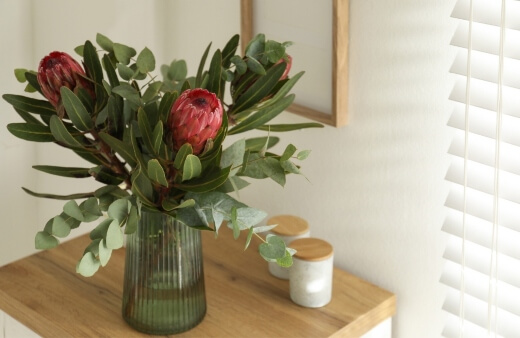
- Cuttings should be taken in late summer to autumn when the wood is semi-hard.
- Using a sterilised and sharp tool, take a 20 to 25 centimetre cutting from the parent plant in the early morning before the heat of the day has set in.
- Prepare a propagation container with a soilless medium like equal parts coconut coir and perlite.
- Remove the leaves from the bottom half of your cuttings stem and dip the planting end into some rooting hormone.
- Plant the cutting about one-third of the stem’s length into your mix.
- Place the container in a warm and humid location with good ventilation to prevent any fungal issues.
- Water well and mist regularly.
- Let your cutting establish new growth and roots for a month or so before transplanting.
Helpful Guide: How to Take Cuttings – Ultimate Propagation Guide
How to Plant Protea
Planting Protea Seedling in the Garden
- Choose a spot in your garden that gets full sun and plenty of ventilation.
- Pre-prepare the area with some organic mulch and compost for added nutrients.
- Dig a planting hole that is twice as wide and to the same depth as the starter plant's root ball.
- Gently remove the seedling from its current container, taking care not to disturb the roots as much as possible.
- Position the plant in your hole and slowly backfill with soil, gently firming the soil around the plant for a sturdy foundation.
- Water your young protea regularly while it grows, especially if there is little rain.
- Mulch as needed when your plant starts to show healthy new growth and development.
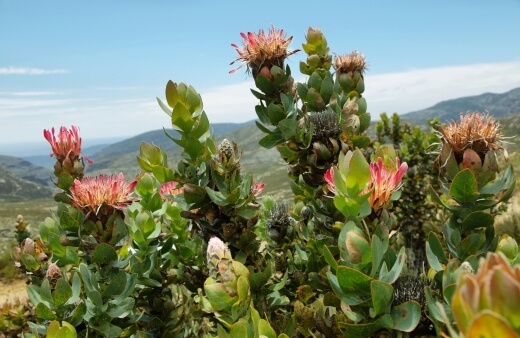
Planting Protea Seedling in a Pot
- Choose a pot or container that is at least double the size of your young plant.
- Your pot should also feature good drainage and allow the plant to get healthy amounts of air circulation.
- Prepare your pot with a quality and coarse potting mix.
- Dig a hole big enough for the root ball of your plant to fit comfortably.
- Gently transfer the plant into your hole and water well.
- You can lightly mulch around the plant if needed.
- Place your pot in a location that gets plenty of sunlight and water regularly while the plant is developing.
Protea Care Tips
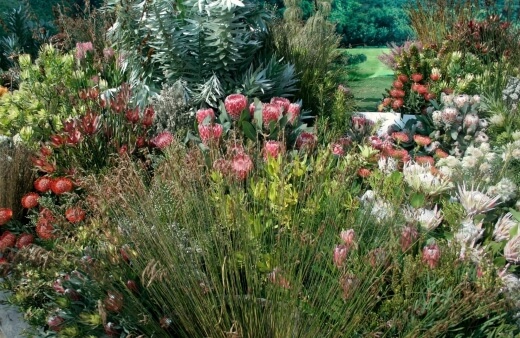
Watering Schedule
Once matured, proteas have very low water needs. After about the first year, you can water about once per week, especially in hot and dry spells or when it's the flowering season.
They are also drought-tolerant so try to avoid overwatering. Potted proteas may need a little more water as the soil will dry out a little faster than a garden bed.
Fertilising Protea
Fertilising proteas is not recommended as their roots absorb nutrients quickly and are sensitive to phosphorus. If you feel your plant may need a boost, rather consider using organic mulch.
Mulching
Apply a leaf or bark mulch around the drip line of your plant, away from the trunk in the growing seasons about once per month. When mulching, pull out any weeds by hand to keep the area clean.
Useful Guide: Best Types of Mulch - When and How to Use It
Pruning Protea
It is considered best practice to pick the spent flowers from your plant by hand rather than hard-pruning them. You can remove some stems if needed.
Prune only the flowered stems and not the un-flowered stems as those are next season's blooms. For young plants, tip prune in spring and summer to encourage bushy growth.
Protea Frequently Asked Questions

Are proteas hard to grow?
These plants are not for beginners as they can be fussy with conditions and climates. They need heat, sun and well-draining soil to thrive. However, if you’re up for the challenge, these plants are worth the effort and the unique showy flowers can easily elevate the appeal of your garden.
Do proteas flower all year round?
Certain species and cultivars can flower all year in the right conditions. However, most proteas flower in late winter to spring, exactly when the garden needs some colour and life.
Are proteas toxic?
Yes. The flowers, nectar and seeds are highly poisonous to humans and pets so the location will need to be considered accordingly. All parts of the plant can also cause skin irritation and inflammation in the mouth and tongue if consumed.

Prop Up Your Garden with the Protea
Sharing so many similarities with some of our most cherished native plants, proteas can quickly add spectacle and wild texture to any garden setting.
If you’re a fan of wildflowers and are up for a bit of a challenge, the protea is the perfect pick to help elevate your outdoor spaces. With so many exciting varieties and cultivars to choose from, you’re bound to find the right protea for your gardening needs.
Published on June 11, 2022 by Maisie Blevins
Last Updated on February 21, 2025


